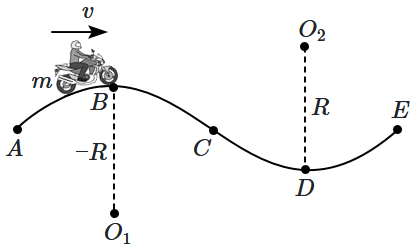A motorcyclist drives on a road \(ABCDE\), where the initial part is curved 'upward' \((O_1B=R)\) and the final part is curved 'downward' \((O_2D=R)\). The total mass (man + motorcycle) is \(m\), and man's speed \(v\) is constant. Let the normal reactions at \(B,D\) be \(N_B, N_D\) respectively.

Then:
1.
\(N_{B}=m g+\dfrac{m v^{2}}{R}\)
\(N_{D}=m g-\dfrac{m v^{2}}{R}\)
2.
\(N_{B}=m g-\dfrac{m v^{2}}{R}\)
\(N_{D}=m g+\dfrac{m v^{2}}{R}\)
3.
\(N_{B}=m g+\dfrac{m v^{2}}{R}\)
\(N_{D}=\dfrac{m v^{2}}{R}-m g\)
4.
\(N_{B}=\dfrac{m v^{2}}{R}-m g\)
\(N_{D}=\dfrac{m v^{2}}{R}+m g\)

\(N_{D}=m g-\dfrac{m v^{2}}{R}\)
\(N_{D}=m g+\dfrac{m v^{2}}{R}\)
\(N_{D}=\dfrac{m v^{2}}{R}-m g\)
\(N_{D}=\dfrac{m v^{2}}{R}+m g\)

To unlock all the explanations of this course, you need to be enrolled.

To unlock all the explanations of this course, you need to be enrolled.
A block of mass \(m\) is placed on a smooth inclined surface of a wedge of mass \(M\). The system is placed on a smooth horizontal table and released.

| 1. | The acceleration of \(m\) is \(g\sin\theta\), and that of \(M\) is zero. |
| 2. | The acceleration of \(m\) is less than \(g\sin\theta\), and that of \(M\) is to the left. |
| 3. | The acceleration of \(m\) is greater than \(g\sin\theta\), and that of \(M\) is to the left. |
| 4. | Any of the above may be true depending on the values of \(m\) and \(M\). |

To unlock all the explanations of this course, you need to be enrolled.

To unlock all the explanations of this course, you need to be enrolled.
The two blocks \(A\) and \(B\) are placed on a smooth horizontal plane, with the string initially just taut. Forces are applied as shown. The tension in the string is:

| 1. | \(5~\text{N}\) | 2. | \(2~\text{N}\) |
| 3. | \(1~\text{N}\) | 4. | \(0~\text{N}\) |

To unlock all the explanations of this course, you need to be enrolled.

To unlock all the explanations of this course, you need to be enrolled.
The two blocks are at rest on a smooth horizontal plane and are connected by strings passing over a smooth light pulley as shown. The strings are vertical while the force \(F,\) applied to the pulley is vertical. For what minimum value of \(F\) will the \(2\) kg block be lifted off?
(\(g=10\) m/s2)
| 1. | \(20\) N | 2. | \(30\) N |
| 3. | \(25\) N | 4. | \(40\) N |

To unlock all the explanations of this course, you need to be enrolled.

To unlock all the explanations of this course, you need to be enrolled.
An elevator moving up is decelerating at \(1\) m/s2. Then, the apparent weight of a \(50\) kg man, on a weighing machine, will be: (take \(g=\) \(10\) m/s2)
| 1. | \(55\) kg | 2. | \(45\) kg |
| 3. | \(40\) kg | 4. | none of the above |

To unlock all the explanations of this course, you need to be enrolled.

To unlock all the explanations of this course, you need to be enrolled.
An astronaut, in a space shuttle, orbiting close to the earth's surface (take \(g= 10~\text{m/s}^2\)), suddenly fires his engines so as to give him a forward acceleration of \(\dfrac{3g}{4}\) along the direction of his motion. At that instant, his apparent weight is:
| 1. | \(25\%\) more than his real weight. |
| 2. | \(25\%\) less than his real weight. |
| 3. | \(75\%\) more than his real weight. |
| 4. | \(75\%\) less than his real weight. |

To unlock all the explanations of this course, you need to be enrolled.

To unlock all the explanations of this course, you need to be enrolled.
The mass \(m\) can slide along a smooth radial groove in a horizontal turntable; at the other end is attached a spring- so that the mass \(m\) presses against the spring as it moves 'outward'. The free-end (\(A\)) of the spring is at a distance \(b\) from the centre and the spring constant is \(k.\) If the turntable is rotated with an angular speed \(\omega\), and the mass \(m\) is in 'equilibrium' with the spring compressed, then the compression is:

| 1. | \(\dfrac{m\omega^2b}{k}\) |
| 2. | \(\dfrac{m\omega^2b}{k-m\omega^2}\) |
| 3. | \(\dfrac{m\omega^2b}{m\omega^2-k}\) |
| 4. | \(\dfrac{m\omega^2b}{m\omega^2+k}\) |

To unlock all the explanations of this course, you need to be enrolled.

To unlock all the explanations of this course, you need to be enrolled.
1. \(1000~\text{N}\)
2. \(2500~\text{N}\)
3. \(1500~\text{N}\)
4. \(3500~\text{N}\)

To unlock all the explanations of this course, you need to be enrolled.

To unlock all the explanations of this course, you need to be enrolled.
A ball of mass \(m\) falls from a height \(h\) onto the ground and rebounds to a height \(\dfrac{h}{4}\). The impulse on the ball from the ground has the magnitude:
| 1. | \(\dfrac{3}{4}m\sqrt{2gh}\) |
| 2. | \(\dfrac{5}{4}m\sqrt{2gh}\) |
| 3. | \(\dfrac{3}{2}m\sqrt{2gh}\) |
| 4. | \(\dfrac{1}{2}m\sqrt{2gh}\) |

To unlock all the explanations of this course, you need to be enrolled.

To unlock all the explanations of this course, you need to be enrolled.
A wire connects two blocks of masses \(M\), \(2M\); both lying on a smooth horizontal plane.

When a force \(F_1\) is applied to \(2M\) as shown in figure 1, the wire just breaks. On the other hand, when \(F_2\) is applied to \(M\) as shown in figure 2,

the wire just breaks. Assume that the mass of the wire is negligible. Then:
| 1. | \(F_1 =F_2\) |
| 2. | \(F_1>F_2\) |
| 3. | \(F_1<F_2\) |
| 4. | Any of the above is possible |

To unlock all the explanations of this course, you need to be enrolled.

To unlock all the explanations of this course, you need to be enrolled.








